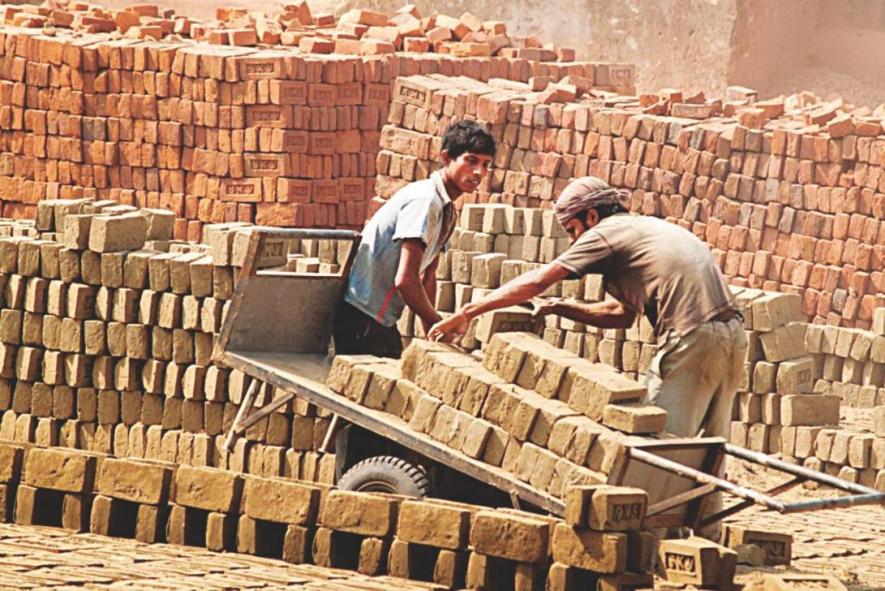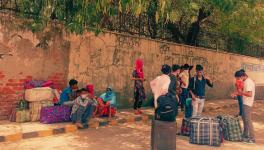COVID-19 Lockdown Cost Livelihood of 78% Informal Sector Workers, Says Survey

Representational Image. Image Courtesy: The Daily Star
The COVID-19 pandemic has thrown the workers, especially in the informal sector, into a deep crisis. A recent report “Workers in the Time of COVID-19" on informal workers says that more than 78% of workers have lost their livelihoods since the pandemic-induced lockdown.
The survey by ActionAid India among 11,537 informal workers across 20 states and one union territory describes how the informal workers have been suffering since the first day of the countrywide lockdown.
According to the survey conducted during the third phase of the lockdown, more than 78% of respondents reported a loss of livelihood and that there was major reduction in the intensity of work. Two third of workers, who had at least above 40 hours work and a third of workers in all sectors (agriculture, manufacturing, construction, and service), who worked over 50 hours a week before the lockdown, have reported zero working workers after lockdown.
Meanwhile, wages have not been regular since the lockdown, with the survey saying, “Over 48% of respondents did not receive any wages after the lockdown and 17% received partial wages.”
In terms of landowning, it is important to note that only 28% of the respondents own land.
Speaking on the occasion of the release Sandeep Chachra, Executive Director, ActionAid Association, said, “The pandemic has revealed the limits of our society and economy's systems and processes. The spread of COVID-19 has shown us the limits of our imaginations. We have seen that governments are struggling to respond effectively to the massive shock the system has had to bear. The socioeconomic gains of the past few decades, such as in reducing absolute poverty and food insecurity have suffered massive setbacks.”
“At the same time, fissures based on caste, religion, gender are getting broader and more profound. This is a crucial moment, both for policymakers and civil society as a whole, to critically reflect upon what will make our communities resilient. We must imbibe lessons about the choices we need to make, the tools we should deploy and the institutions and mechanisms we must build and strengthen. Systemic change of the kind that is required for progress is only possible once structural fault lines are acknowledged and understood,” he added.
Around 57% of respondents said that they migrate once a year and 43% migrate multiple times a year. Those who migrate only once a year mostly migrate to the same town or city, while a large percentage of those who migrate multiple times a year move to multiple cities and towns. As per the study, such migrations have implications for the worker’s employment stability and the ability to develop social networks. Of these, “around 44% of the workers migrate with family, which adds to their vulnerability in the destination state because of the higher number of dependents.”
Also read: Covid-19 Crisis Exposes India’s Neglect of Informal Workers
Again the report points to the fact that 56% of migrants do not migrate with family is indicative of the poor living and working conditions in their destination states and their desire to maximise their savings and remittances.
Of the respondents, around 63% have migrated for employment. The social composition of the total respondents consists of 15% from scheduled tribes and 39% from scheduled castes, which is higher than their proportion in the composition of the country’s population.
“Labour market segmentation is, therefore, reinforcing employment of marginalised communities in low wage low productivity sectors and constraining the prospects of marginalised communities for upward mobility,” the survey says.
The living conditions of most of these workers are pathetic. Only around 13% of workers have a rent agreement, 8% have patta. A majority of the migrant workers live in rented housing (55%), while 9% were given housing by their employer and 8% lived in some form of community housing. Most workers lived with six to 10 people and shared one toilet and one room.
However, after the lockdown, around 60% of migrants had to vacate their housing. They were forced to vacate their housing because of a loss of livelihood (44%), inability to pay rent (19%), closure of factories (18%t), and eviction by landlords or employers (5%).
As the lockdown had resulted in the loss of their livelihood, workers have been forced to borrow money to survive, which has resulted in worsening of conditions of workers. About 55% of respondents already had outstanding debts before the lockdown that further increased during the lockdown. Out of them, 83% lost their livelihoods after the lockdown adding to the precarity of their situation. Around 60% of respondents borrowed money to meet living costs and expenses such as family emergencies and healthcare during the lockdown.
Additionally, “95% of respondents said that their savings are barely sufficient or not sufficient”.
Reduction in Consumption Food
As the workers have been thrown into a much insecure situation after the lockdown, it even resulted in the reduction in consumption of food. Of the participants in the survey, around 18.5% of respondents said that their food consumption was sufficient. While 63% of respondents were eating two meals a day, 34% said that they could eat only once a day and 3% reported eating only once in two days.
Though the workers are in a precarious situation, they alleged to have not received any assistance from the authorities. “Most respondents received no cash, transport, food or shelter assistance from any source during the lockdown. Approximately 79% received no cash assistance, 44% received no food assistance, and 85% did not receive any shelter assistance,” according to the report.
During the initial phase of the lockdown, the country has seen the migrant workers walking hundreds of kilometres to reach back at their native villages without proper food and water. As per the survey, more than 50% migrants reported that they were stranded for over a month, yet more than 70% migrants said that they did not receive any transport assistance.
“Of all sources, the government was the single largest provider of assistance in each category (food, shelter, cash, transport). However, if we compare the overall percentage of workers who received assistance from nongovernmental sources including NGOs, self-help groups, trade unions and employers with the percentage of workers who received assistance from the government for each category, then the percentage of workers who received assistance from non-governmental sources is higher,” the survey adds.
Also read: ‘In Chennai, 71% Resident Informal Workers Lost Jobs in Past 2 Months’
Not only that, the lack of legal recognition deprives the rights of workers. As per the survey, 90%t of respondents do not have written employment contract in our survey, which makes it extremely difficult to enforce any labour laws. “Enrolment and Access to Entitlements Enrolment was low across schemes such as Antodaya Anna Yojana (27%), PM Kisan Samridhi (5%), ICDS (7%), Jan dhan Yojana (23%), Ujjwala Yojana (23%), and pension schemes (6%),” it says.
The survey also suggests that in order to control the spread of the disease in a manner which ensures people’s access to essential services, upholds their rights, and does not create distrust and panic, it is necessary to evolve village level and district level plans with community participation. They also urge an immediate focus on rebuilding the livelihoods of informal workers.
Get the latest reports & analysis with people's perspective on Protests, movements & deep analytical videos, discussions of the current affairs in your Telegram app. Subscribe to NewsClick's Telegram channel & get Real-Time updates on stories, as they get published on our website.
























